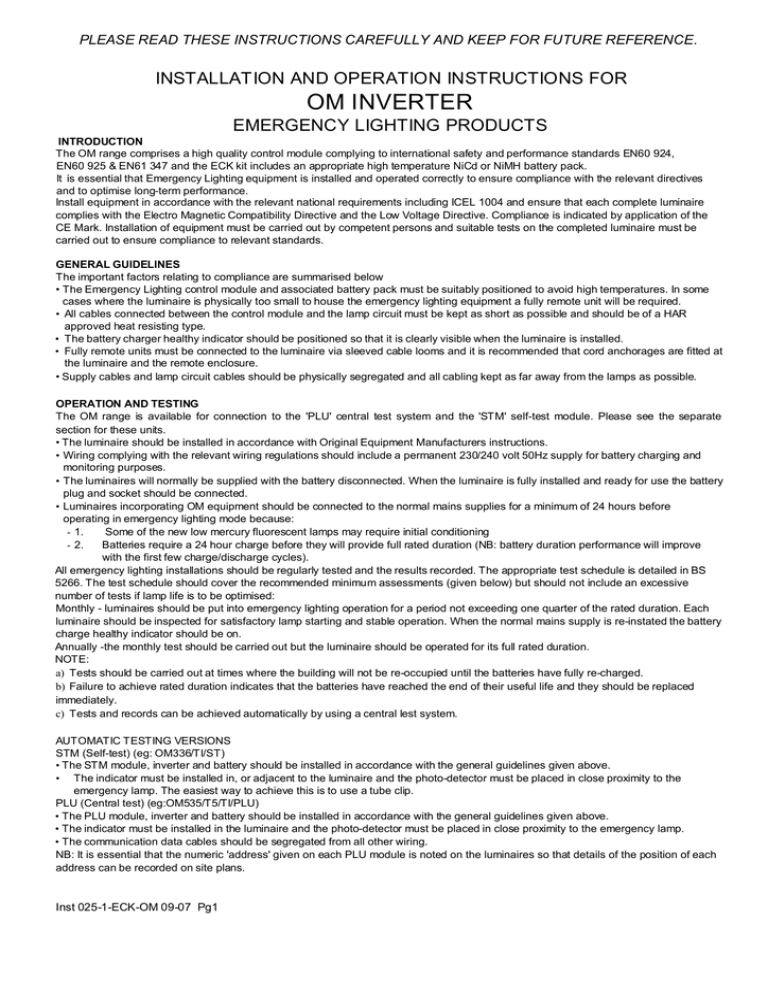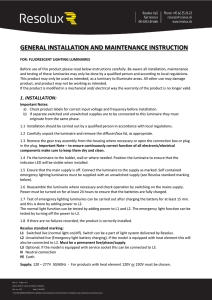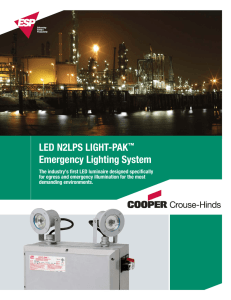ECK/OM Installation Instructions
advertisement

PLEASE READ THESE INSTRUCTIONS CAREFULLY AND KEEP FOR FUTURE REFERENCE. INSTALLATION AND OPERATION INSTRUCTIONS FOR OM INVERTER EMERGENCY LIGHTING PRODUCTS INTRODUCTION The OM range comprises a high quality control module complying to international safety and performance standards EN60 924, EN60 925 & EN61 347 and the ECK kit includes an appropriate high temperature NiCd or NiMH battery pack. It is essential that Emergency Lighting equipment is installed and operated correctly to ensure compliance with the relevant directives and to optimise long-term performance. Install equipment in accordance with the relevant national requirements including ICEL 1004 and ensure that each complete luminaire complies with the Electro Magnetic Compatibility Directive and the Low Voltage Directive. Compliance is indicated by application of the CE Mark. Installation of equipment must be carried out by competent persons and suitable tests on the completed luminaire must be carried out to ensure compliance to relevant standards. GENERAL GUIDELINES The important factors relating to compliance are summarised below • The Emergency Lighting control module and associated battery pack must be suitably positioned to avoid high temperatures. In some cases where the luminaire is physically too small to house the emergency lighting equipment a fully remote unit will be required. • All cables connected between the control module and the lamp circuit must be kept as short as possible and should be of a HAR approved heat resisting type. • The battery charger healthy indicator should be positioned so that it is clearly visible when the luminaire is installed. • Fully remote units must be connected to the luminaire via sleeved cable looms and it is recommended that cord anchorages are fitted at the luminaire and the remote enclosure. • Supply cables and lamp circuit cables should be physically segregated and all cabling kept as far away from the lamps as possible. OPERATION AND TESTING The OM range is available for connection to the 'PLU' central test system and the 'STM' self-test module. Please see the separate section for these units. • The luminaire should be installed in accordance with Original Equipment Manufacturers instructions. • Wiring complying with the relevant wiring regulations should include a permanent 230/240 volt 50Hz supply for battery charging and monitoring purposes. • The luminaires will normally be supplied with the battery disconnected. When the luminaire is fully installed and ready for use the battery plug and socket should be connected. • Luminaires incorporating OM equipment should be connected to the normal mains supplies for a minimum of 24 hours before operating in emergency lighting mode because: - 1. Some of the new low mercury fluorescent lamps may require initial conditioning - 2. Batteries require a 24 hour charge before they will provide full rated duration (NB: battery duration performance will improve with the first few charge/discharge cycles). All emergency lighting installations should be regularly tested and the results recorded. The appropriate test schedule is detailed in BS 5266. The test schedule should cover the recommended minimum assessments (given below) but should not include an excessive number of tests if lamp life is to be optimised: Monthly - luminaires should be put into emergency lighting operation for a period not exceeding one quarter of the rated duration. Each luminaire should be inspected for satisfactory lamp starting and stable operation. When the normal mains supply is re-instated the battery charge healthy indicator should be on. Annually -the monthly test should be carried out but the luminaire should be operated for its full rated duration. NOTE: a) Tests should be carried out at times where the building will not be re-occupied until the batteries have fully re-charged. b) Failure to achieve rated duration indicates that the batteries have reached the end of their useful life and they should be replaced immediately. c) Tests and records can be achieved automatically by using a central lest system. AUTOMATIC TESTING VERSIONS STM (Self-test) (eg: OM336/TI/ST) • The STM module, inverter and battery should be installed in accordance with the general guidelines given above. • The indicator must be installed in, or adjacent to the luminaire and the photo-detector must be placed in close proximity to the emergency lamp. The easiest way to achieve this is to use a tube clip. PLU (Central test) (eg:OM535/T5/TI/PLU) • The PLU module, inverter and battery should be installed in accordance with the general guidelines given above. • The indicator must be installed in the luminaire and the photo-detector must be placed in close proximity to the emergency lamp. • The communication data cables should be segregated from all other wiring. NB: It is essential that the numeric 'address' given on each PLU module is noted on the luminaires so that details of the position of each address can be recorded on site plans. Inst 025-1-ECK-OM 09-07 Pg1 ADDITIONAL INFORMATION REGARDING OM/RE REMOTE CONVERSIONS The standard OM/RE remote conversion unit is provided with input terminals for the normal mains lighting switched supply and the permanent live for circuit monitoring and battery charging. Therefore two sleeved cable looms may be connected from the OM/RE to the luminaires. One will provide the mains supply (L N & E) and the other will have the connections for the emergency lamp. SAFETY INFORMATION Emergency lighting circuits generate very high open circuit voltages and the circuits may be live even when the lamp is not operating. Always disconnect the batteries before servicing. The electronics and batteries will be damaged by excessive temperatures and it is therefore important that the luminaire is always operated within the declared ‘ta’ ambient temperature range. Batteries have a typical life expectancy of four to five years. Old batteries should be handled by specialist waste disposal experts, under no circumstances should they be pierced or incinerated. The standard colour coding from the conversion wiring to the OM/RE remote unit: Cable Loom 1 Cable Loom 2 Terminal Colour Terminal Colour 1 White L Out Brown 2 Yellow N Blue 3 Grey E Green/Yellow 4 Violet 5 Yellow 6 White 7 Violet 8 Grey CONVERSION WIRING FOR ‘OM’ MODULES (HF BALLASTS) CONVERSION WIRING FOR LOW PROFILE ‘OM/LP’ MODULES Inst 025-1-ECK-OM 09-07 Pg2



